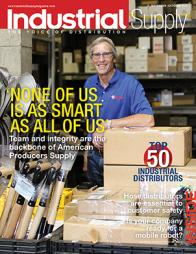Who will fill your shoes?
Industrial distributors are using multiple methods to hire the next generation of workers
by Mary Jawgiel
Across the continent, industrial distributors are trying various methods to recruit and hire skilled employees in order to keep their businesses running smoothly and growing steadily. The big fear is the exodus of Baby Boomers who will begin retiring in droves in the next few years, leaving a brain drain in their wake. But where does one look to find talented, loyal, trustworthy, skilled workers in this day and age? The Boy Scouts are not quite old enough yet.
A recent survey conducted on behalf of Industrial Careers Pathway by the NAW Institute for Distribution Excellence found that most distributors (37 percent) look to word-of-mouth help from friends, current employees and family to fill job openings. It’s not uncommon for aunts, uncles, nephews, nieces, cousins, grandparents, grandkids, parents and adult children all to be working in a professional capacity for the same company. Even companies that are not family owned.
But will word-of-mouth hiring be enough to fill the open highly skilled labor jobs that are the crux of the industry? Hiring good solid people and then providing training is one avenue that distributors are exploring. A recent article in the Chicago Tribune highlighted one manufacturing company that is investing $400,000 to provide college degrees for some of its most loyal and productive staff.
To accommodate these employees’ work schedules, professors come to the workplace and offer courses after work shifts end. The company footing the bill is counting on worker loyalty to ensure these highly educated workers stick around after earning their degrees.
Other employers hire talent after they earn degrees or have spent a couple of years in college, but before they learn the business of industrial distribution. Training in the field and product training offered by manufacturers and associations is readily available for nominal costs by many organizations (including the associations that support the ICP initiative). Sometimes training is even free (with commercial pitches added in) by outside suppliers. But training takes young workers away from their day-to-day jobs, so hidden training costs can add up for employers. Still, hiring good people who know little about the business of industrial distribution and then training them is a good way to develop a skilled work force.
Another way to train newer workers is through in-house formal mentoring programs. Mentoring programs help transition institutional knowledge from one generation to another, and often build a special camaraderie between the mentor and the mentee. Mentoring programs can be a highly effective, affordable and rewarding means of education and training for new workers. As an added bonus of starting a mentoring program, you might benefit from a recent twist on mentoring programs (made famous by Jack Welch) known as reverse mentoring. This is where the young people teach the older people a few tricks, especially in the technology arena!
Standard mentoring can be fraught with pitfalls however. There is the fear by older workers of losing the power they have due to their wealth of knowledge. The thinking goes, “If I tell you all my tricks, why will they need me anymore?” Training mentors is strongly advised before a program is started. Check out www.mentoring.org and www.mentoring-association.org for some tips and ideas.
Some companies are partnering with area schools to develop curricula suited to their specific needs and are then offering internships to get the best and brightest of those learners into the workplace. Then the students can get to know the company, and the company can get to know the students before a long-term commitment is established. This method of developing a labor pipeline offers a low-cost solution for employers, but most likely employers will find there is a large up-front time investment in getting a community-based program like this going. Coalition building to get other businesses on board, working with a revolving door of school administrators and educators, haggling over curriculum and recruiting students into the program are various undertakings that can add years to the development of a successful program.
We know of which we speak. ICP was created 10 years ago and hit upon this strategy to develop a pipeline of labor for industrial distribution. While success stories were chalked up, each one made it to the finish line in very different ways, in varying models. We found each endeavor with each educational institution to be unique, difficult to replicate and time-consuming. That being said, ICP did earn a wealth of experience on the topic, which we are happy to share for no charge with our Alliance Partners and Ambassador Corps volunteers who are willing to take on the challenge.
Searching for former military veterans to come to work is a strategy that a few employers are tackling. In the NAW/ICP survey, just 17 percent said they were actively looking for vets. There are a number of organizations, especially state-based workforce development boards, nonprofit veterans groups and for-profit corporations, that are networking to find jobs for former vets.
Advertising for skilled labor is another way to fill the labor pipeline. But where to advertise is always a challenge for companies with limited advertising dollars. The trade magazines? Which ones? The major job boards? Just to get lost in a sea of similar pleas for help at $400 a pop? Newspapers? What are those anyway? Ask any person under 35 when the last time they picked up a newspaper was and you’ll most likely be met with a blank stare.
Industrial distributors are not just competing with one another for new hires. We are competing with the healthcare industry, the high-tech and IT industries, the financial industry and, of course, consumer-products giants for the best and brightest. With deep pockets and big mouths, these competitors can be daunting. But together, industrial distributors and the manufacturers who rely on distribution are a powerful force. Together, we can get the word out to a young audience looking for good, stable jobs in an industry where their skills and education will be valued. Those lucky enough to listen will be rewarded for what they know now and what they will learn.
Industrial Careers Pathway is working on a program to assist the industry in attracting young people to the field and away from competing industries. Industrial distributors will still need to attract these workers to their specific companies, but at least, hopefully, they’ll be looking for jobs in our field and not healthcare or Wall Street.
 Mary Jawgiel is ICP program director for the PTDA Foundation. Working with young people is a life-long passion for Mary, who has spent her entire career attracting young graduates to careers that become life-long passions for them. ICP (Industrial Careers Pathway) is a cross-industry initiative supported by the ISA Foundation, NAHAD: The Association for Hose and Accessories Distribution and the PTDA Foundation. Subscribe to the ICP Talent Tipsheet for more insights on working effectively across generations by visiting www.industrialcareerspathway.org/subscribe.
Mary Jawgiel is ICP program director for the PTDA Foundation. Working with young people is a life-long passion for Mary, who has spent her entire career attracting young graduates to careers that become life-long passions for them. ICP (Industrial Careers Pathway) is a cross-industry initiative supported by the ISA Foundation, NAHAD: The Association for Hose and Accessories Distribution and the PTDA Foundation. Subscribe to the ICP Talent Tipsheet for more insights on working effectively across generations by visiting www.industrialcareerspathway.org/subscribe.
This article originally appeared in the May/June 2012 issue of Industrial Supply magazine. Copyright 2012, Direct Business Media.













